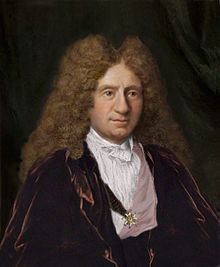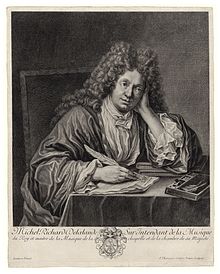cultură şi spiritualitate

Michel Richard Delalande [de Lalande] (15 December 1657 – 18 June 1726) was a French Baroque composer and organist who was in the service of King Louis XIV. He was one of the most important composers of grands motets. He also wrote orchestral suites known as Simphonies pour les Soupers du Roy and ballets.
Biography
Born in Paris, he was a contemporary of Jean-Baptiste Lully and François Couperin. Delalande taught music to the daughters of Louis XIV of France, and was director of the French chapel royal from 1714 until his death at Versailles in 1726.
Delalande was arguably the greatest composer of French grands motets, a type of sacred work that was more pleasing to Louis XIV because of its pomp and grandeur, written for soloists, choir and comparatively large orchestra. According to tradition, Louis XIV organized a contest between composers, giving them the same sacred text and time to compose the musical setting. He alone was the judge. Delalande was one of four winners assigned to compose sacred music for each quarter of the year (the other composers being Coupillet, Collasse and Minoret). Delalande's was the most important quarter of the year because of the Christmas holiday. Later he had full responsibility for the church music for the complete year. At his death, since he left no mass of his own, the 1656 requiem of the Dukes of Lorraine by Charles d'Helfer was sung.
Works
Delalande left many versions of his works. His earlier versions show adherence to French Baroque style, but the later revisions incorporate more Italian melismatic lines and greater attention to polyphonic counterpoint.
Also, at least four collections of his works exist, each displaying different looks at composer's work as viewed by the people who assembled each collection.
Scholarship of Delalande's work was for many years hindered because of inconsistencies in the spelling of his last name: de Lalande, Lalande, la Lande, de la Lande, and others. The family wrote the name as 'Delalande'. Finally, in 2006 the definitive "Thematic Catalogue of the Works of Michel-Richard de Lalande (1657-1726)" by noted British musicologist Lionel Sawkins came out which runs to 752 pages containing over 3,000 music examples and details of performing requirements and of all source materials, as well as with comprehensive indexes and thematic locators.
Vocal
- grands motets - Latin settings of psalms including Lalande's Te Deum (1684).
- petits motets - shorter Latin settings for a few vocal and instrumental soloists and continuo, including élévations on an eucharistic text sung at the elevation of the communion wafers.
Instrumental Lalande was an expert organist and harpsichordist, and yet has left not a single note of keyboard music.[1]
- ritournelles - twelve substantial ritournelles for François Fossard and André Danican Philidor's book of Airs italiens (1695). For example, Lalande supplies a 31-bar-long ritournelle for two violins and continuo composed before ‘Giurai di non amar’ an aria from Domenico Freschi's Olimpia vendicata of 1681.[2]
Selected recordings
- Symphonies pour les soupers du Roy. Hugo Reyne (HMA)
- Les Folies de Cardenio. Christophe Coin (Laborie) - court ballet, "The Insanities of Cardenio", after Cervantes.
- Grands Motets : Te Deum, Confitebor, Super Flumina. Christie (HMA)
- Grands Motets : De Profundis, Miserere, Confitebor tibi. Higginbottom (Erato)
- Grands Motets : Dies Irae. Miserere. Herreweghe (HMC901352)
- Grands Motets : Beati quorum. Quam dilecta. Audite caeli. Schneebeli (Virgin) 2002
- Grands Motets : Deus noster refugium Ps.46. Exaltabo te Domine. Le Parlement de Musique. Martin Gester (Opus 111)
- Grands Motets : Regina coeli. De Profundis. Cantate Domino. Skidmore (ASV)
- Petits motets: Miserere à voix seule. Vanum est vobis. Gens, Piau, Christie (HMT)
- 3 Leçons de Ténèbres 1730. Desrochers (Astree)
Delalande’s Symphonies pour les Soupers du Roy form one of the most famous works in the French musical patrimony. To music lovers it is probably the best-known work of French baroque instrumental music. In 1689 Delalande was appointed ‘’surintendant de la musique de la chambre du roi’’, and it was probably in 1690 that he embarked on the composition of a first suite of instrumental airs to embellish the suppers of Louis XIV, The composition of the first suite ten suites was to extend over the next ten years. It was only in 1713 that Delalande was to add an eleventh and then a twelfth. During the last two years of his life Louis XIV could choose from among these twelve suites the music to accompany his suppers.
The King’s Supper was taken at ten o’clock in the evening either in the King’s Antechamber of the Antechamber of the ‘’Grand Couvert’’ (ceremonial table-setting). The king supped in public. The menu consisted of four courses : the soups, the entrées, the roasts and the sweets. beside the initial fanfare (Concert de Trompettes), for the entrance of the King, which coincided with the arrival of the first course, we believe that Delalande’s music was played between the end of one course and the arrival of the next, intervening three times, which would explain the tripartite organization of the suites. The supper need at about eleven o’clock and its conclusion was probably punctuated by another fanfare.
A large number of 17th and 18th century composers have left us ‘’table-music’’, a fine example being Telemann’s Tafelmusik (1733). But the most monumental example remains Delalande’s Symphonies pour les Soupers du Roy. At the end of the 17th century the word symphonie had nothing like the meaning it has today. Symphonie or simphonie was a general term for any instrumental composition (overture, prelude, dance, ritornello before the entry a voice, etc.), but also designated the instrumental ensemble that played it, in opposition to the term choeur (chorus), which designated, as it still does, the vocal composition and the ensemble singing it.
Delalande’s twelve suites of Symphonies consists of three types of music : purely instrumental music, music of a dance-like character, and instrumental ada stations of vocal music. In the first type we find overtures, preludes, airs not related to dances, and above all, the caprices in the 5th, 7th and 12th suites, among them the famous ‘’Fantaisie que le Roy demandoit souvent’’ (Fantasy that the King often requested) that prefigures what was to become the classical symphony. In the second type we have all the dances, that is, the sarabandes, passacailles, chaconnes, minuets, passepieds, loures, gigues, canaries, gavottes, bourrées, rigaudons and so on, that were characteristic of the French suite. Finally, in the third type there are the airs sung during the ballets, orchestrated by the composer in such a way as to replace the voice (or voices) originally intended. Nonetheless, we have not been able to resist performing some of them in the sung version. Hugo REYNE
Baroque composers PLAYLIST (reference recordings) https://www.youtube.com/playlist?list...
Adaugă un comentariu
© 2024 Created by altmarius.
Oferit de
![]()
Embleme | Raportare eroare | Termeni de utilizare a serviciilor














Pentru a putea adăuga comentarii trebuie să fii membru al altmarius !
Alătură-te reţelei altmarius